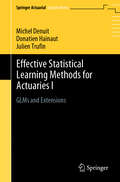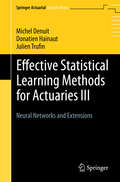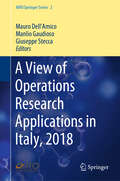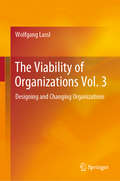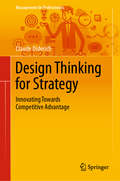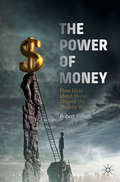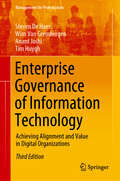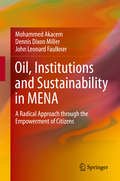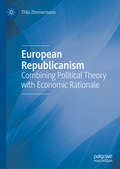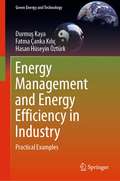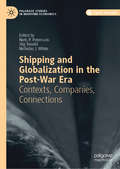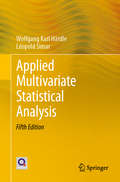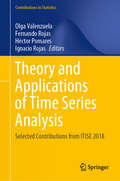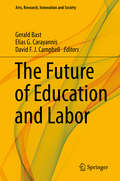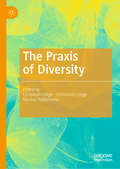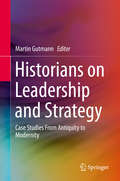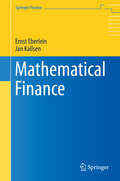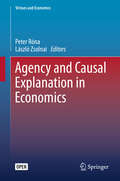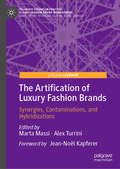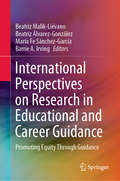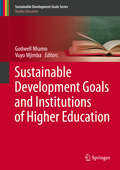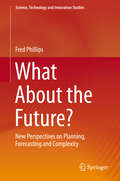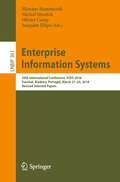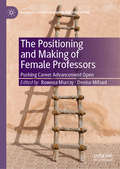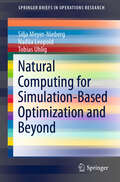- Table View
- List View
Effective Statistical Learning Methods for Actuaries I: GLMs and Extensions (Springer Actuarial)
by Michel Denuit Donatien Hainaut Julien TrufinThis book summarizes the state of the art in generalized linear models (GLMs) and their various extensions: GAMs, mixed models and credibility, and some nonlinear variants (GNMs). In order to deal with tail events, analytical tools from Extreme Value Theory are presented. Going beyond mean modeling, it considers volatility modeling (double GLMs) and the general modeling of location, scale and shape parameters (GAMLSS). Actuaries need these advanced analytical tools to turn the massive data sets now at their disposal into opportunities. The exposition alternates between methodological aspects and case studies, providing numerical illustrations using the R statistical software. The technical prerequisites are kept at a reasonable level in order to reach a broad readership. This is the first of three volumes entitled Effective Statistical Learning Methods for Actuaries. Written by actuaries for actuaries, this series offers a comprehensive overview of insurance data analytics with applications to P&C, life and health insurance. Although closely related to the other two volumes, this volume can be read independently.
Effective Statistical Learning Methods for Actuaries III: Neural Networks and Extensions (Springer Actuarial)
by Michel Denuit Donatien Hainaut Julien TrufinThis book reviews some of the most recent developments in neural networks, with a focus on applications in actuarial sciences and finance. It simultaneously introduces the relevant tools for developing and analyzing neural networks, in a style that is mathematically rigorous yet accessible. Artificial intelligence and neural networks offer a powerful alternative to statistical methods for analyzing data. Various topics are covered from feed-forward networks to deep learning, such as Bayesian learning, boosting methods and Long Short Term Memory models. All methods are applied to claims, mortality or time-series forecasting. Requiring only a basic knowledge of statistics, this book is written for masters students in the actuarial sciences and for actuaries wishing to update their skills in machine learning. This is the third of three volumes entitled Effective Statistical Learning Methods for Actuaries. Written by actuaries for actuaries, this series offers a comprehensive overview of insurance data analytics with applications to P&C, life and health insurance. Although closely related to the other two volumes, this volume can be read independently.
A View of Operations Research Applications in Italy, 2018 (AIRO Springer Series #2)
by Mauro Dell’Amico Manlio Gaudioso Giuseppe SteccaThis book presents expert descriptions of the successful application of operations research in both the private and the public sector, including in logistics, transportation, product design, production planning and scheduling, and areas of social interest. Each chapter is based on fruitful collaboration between researchers and companies, and company representatives are among the co-authors. The book derives from a 2017 call by the Italian Operations Research Society (AIRO) for information from members on their activities in promoting the use of quantitative techniques, and in particular operations research techniques, in society and industry. A booklet based on this call was issued for the annual AIRO conference, but it was felt that some of the content was of such interest that it deserved wider dissemination in more detailed form. This book is the outcome. It equips practitioners with solutions to real-life decision problems, offers researchers examples of the practical application of operations research methods, and provides Master’s and PhD students with suggestions for research development in various fields.
The Viability of Organizations Vol. 3: Designing and Changing Organizations
by Wolfgang LasslThe design process for organizational structures sometimes resembles a random walk, especially when it is embedded in an arena of competing personal interests and power games. Many organizations still lack clear guidance and are therefore seeking a rigorous, nuanced, and impartial methodology for the design and development of their organizational structures, processes and behavioral repertoire. The Viable System Model (VSM) can help: by identifying the essential design principles and parameters that need to be considered, and which can be used to enhance an organization’s effectiveness, adaptability, cohesion and overall viability.This book, the third volume in a set of three, connects the VSM to the world of the standard organizational chart. It offers readers a new perspective on corporate functions and their contributions to the organization as a whole. Further, it shows them how the VSM can be used to develop viable organizational structures, following a detailed step-by-step approach. Lastly, it explains the vital processes, behaviors, and attitudes that need to be developed in order to make organizations truly viable.Readers will find solutions to, and guidelines on, many critical organizational design issues, e.g. designing job profiles; correctly mapping synergistically (“centrally”) operating units in the organizational chart; outsourcing processes; and handling matrix situations; as well as designing and implementing organizational change processes.
Design Thinking for Strategy: Innovating Towards Competitive Advantage (Management for Professionals)
by Claude DiderichThe business environment is changing more rapidly than ever before, and new business ideas are emerging. This book discusses applying insights from design thinking to craft novel strategies that satisfy customer needs, make use of the available capabilities, integrate requirements for financial success and provide competitive advantage.It guides readers through the jungle encountered when developing a strategy for sustained growth and profitability. It addresses strategy design in a holistic way by applying abductive reasoning, iteratively observing customers and focusing on empathy, as well as prototyping ideas and using customers to validate them. Uniquely applying insights from design thinking to strategy, this book is a must-read for graduates, MBAs and executives interested in innovation and strategy, as well as corporate strategists, innovation managers, business analysts and consultants.
The Power of Money: How Ideas about Money Shaped the Modern World
by Robert PringleInnovation in money is just as important as innovation in any other sphere of activity; money is always a “work in progress.” In fact, history shows societies have tried out a wide diversity of monetary arrangements. Ideas about money have played key roles at crucial turning points in world history and during national histories. Recently, a new global money space has been created, a joint venture between the public and private sector. This book explores the new money society that has grown up to inhabit this new space. The book has several aims: Firstly, the book shows how beliefs about money, as well as attitudes and values towards it, have varied between societies and over time, and specifically how they have changed over the modern era. Secondly, the book shows the powerful effects that changing ideas have had on events, including wars and revolutions, recessions, booms and financial crises. Thirdly, the book recounts the creation of a global money space, dated to the last quarter of the 20th century, and explores its features. Fourthly, the book describes some characteristics of the new money society that inhabits the global money space. Fifthly, the book shows how each society, and indeed successive generations of the same society, has made its own unique arrangements to govern money – i.e. how it comes to terms with the power of money. The author argues that we need to develop a new arrangement now and suggests that we have much to learn from recent creative work in a number of fields ranging from the sociology of money to contemporary art. This approach sheds new light on a number of controversial issues, including the rise of crony capitalism, growing social divisions, currency wars, and asset price bubbles.
Enterprise Governance of Information Technology: Achieving Alignment and Value in Digital Organizations (Management for Professionals)
by Steven De Haes Wim Van Grembergen Anant Joshi Tim HuyghThis book integrates theoretical advances and empirical data on Enterprise Governance in Information Technology (EGIT) with practical applications based on numerous case examples. The third revised edition of Enterprise Governance of Information Technology provides professionals and students with the most recent research advancements as well as an in-depth discussion of the recently-introduced Control Objectives for Information and Related Technologies (COBIT) 2019 framework which can be used to facilitate a tailored implementation of effective EGIT. Furthermore, the book features a new chapter which provides readers with hands-on examples from practice and clear insights on how these relate to theory. At the forefront of the field, the authors of this volume draw from years of research and advising corporate clients to present a comprehensive resource on EGIT. Featuring a variety of elements, including executive summaries and sidebars, extensive references, questions and activities and additional online materials, this book is a valuable updated resource for professionals, students and researchers alike.
Oil, Institutions and Sustainability in MENA: A Radical Approach through the Empowerment of Citizens
by Mohammed Akacem Dennis Dixon Miller John Leonard FaulknerThis book addresses the factors that have led to the lackluster economic performance of the oil MENA region, despite the wealth of its vast natural resource. It offers a radical policy recommendation as a way out. Using data from a wide variety of sources, it analyzes the major problems that confront the governments of the MENA region, and make the case why the status quo is unsustainable. Recently, Algeria has shown that people will tire of the status quo and will demand wholesale changes. At the core of the problem of corruption, rent seeking, waste, and lack of economic diversification, is the presence of oil and its control by the state. But oil by itself should help, not hinder MENA’s economic development. While historically, oil revenues may have contributed to the maintenance of corrupt institutions and rent seeking among oil-rich nations, the mere presence of such valuable natural resources need not be the problem. It argues for a plan to empower citizens and invert the power relationship, so that the citizen’s voices matter. For the spirit of the Arab Spring to be successful, the region must adopt significant institutional changes that embrace the rule of law, transparency, democratic accountability, and the protection of human and private rights.
European Republicanism: Combining Political Theory with Economic Rationale
by Thilo ZimmermannThis book presents current theories of European integration, such as federalism, neo-functionalism and liberal intergovernmentalism with their strengths and weaknesses. It is then argued that the combination of republican theory with public good theory, the res publica of public goods, could better explain European integration. Public good theory has, however, to be adopted in order to make it applicable to European republicanism. Finally, the book demonstrates how this new framework can influence further academic debates, such as on sovereignty and monetary integration, externalities of a common European market and the driving force of European integration. It is maintained that as the republican approach does not follow a pure economic logic, there remains space for political considerations and motivations.In this topical and interdisciplinary book, the author combines many important strings of European integration theory, history, economics and political sciences, which are clearly brought together into a coherent analytical discourse. Its strength is the interdisciplinary interaction between politics and economics, as well as theoretical and practical issues which are of high relevance for public debate in Europe. This book will be of interest to scholars and students interested in economic integration, as well as history and political philosophy.
Energy Management and Energy Efficiency in Industry: Practical Examples (Green Energy and Technology)
by Durmuş Kaya Fatma Çanka Kılıç Hasan Hüseyin ÖztürkThis book is presented to demonstrate how energy efficiency can be achieved in existing systems or in the design of a new system, as well as a guide for energy savings opportunities. Accordingly, the content of the book has been enriched with many examples applied in the industry. Thus, it is aimed to provide energy savings by successfully managing the energy in the readers’ own businesses. The authors primarily present the necessary measurement techniques and measurement tools to be used for energy saving, as well as how to evaluate the methods that can be used for improvements in systems. The book also provides information on how to calculate the investments to be made for these necessary improvements and the payback periods. The book covers topics such as: • Reducing unit production costs by ensuring the reduction of energy costs, • Efficient and quality energy use, • Meeting market needs while maintaining competitive conditions, • Ensuring the protection of the environment by reducing CO2 and CO emissions with energy saving and energy efficiency, • Ensuring the correct usage of systems by carrying out energy audits. In summary, this book explains how to effectively design energy systems and manage energy to increase energy savings. In addition, the study has been strengthened by giving some case studies and their results in the fields of intensive energy consumption in industry. This book is an ideal resource for practitioners, engineers, researchers, academics, employees and investors in the fields of energy, energy management, energy efficiency and energy saving.
Shipping and Globalization in the Post-War Era: Contexts, Companies, Connections (Palgrave Studies in Maritime Economics)
by Niels P. Petersson Stig Tenold Nicholas J. WhiteThis open access book belongs to the Maritime Business and Economic History strand of the Palgrave Studies in Maritime Economics book series.This volume highlights the contribution of the shipping industry to the transformations in business and society of the postwar era. Shipping was both an example and an engine of globalization and structural change. In turn, the industry experienced and pioneered, mirrored and enabled key developments that led to the present-day globalized economy. Contributions address issues such as the macro-level shift of shipping’s centre of gravity from Europe to Asia, the political and legal frameworks within which it developed, the strategies and performance of both successful and unsuccessful firms, and the links between the shipping industry and the wider economy and society. Without shipping and its ability to forge connections and networks of a global reach, the modern world would look very different. By bringing together scholars from various disciplinary and national backgrounds, this book advances our understanding of the linkages that bind economies and societies together.
Applied Multivariate Statistical Analysis
by Wolfgang Karl Härdle Léopold SimarThis textbook presents the tools and concepts used in multivariate data analysis in a style accessible for non-mathematicians and practitioners. All chapters include practical exercises that highlight applications in different multivariate data analysis fields, and all the examples involve high to ultra-high dimensions and represent a number of major fields in big data analysis.For this new edition, the book has been updated and extensively revised and now includes an extended chapter on cluster analysis. All solutions to the exercises are supplemented by R and MATLAB or SAS computer code and can be downloaded from the Quantlet platform. Practical exercises from this book and their solutions can also be found in the accompanying Springer book by W.K. Härdle and Z. Hlávka: Multivariate Statistics - Exercises and Solutions.The Quantlet platform, quantlet.de, quantlet.com, quantlet.org, is an integrated QuantNet environment consisting of different types of statistics-related documents and program codes. Its goal is to promote reproducibility and offer a platform for sharing validated knowledge native to the social web. QuantNet and the corresponding data-driven document-based visualization allow readers to reproduce the tables, pictures and calculations presented in this Springer book.
Theory and Applications of Time Series Analysis: Selected Contributions from ITISE 2018 (Contributions to Statistics)
by Olga Valenzuela Fernando Rojas Héctor Pomares Ignacio RojasThis book presents selected peer-reviewed contributions from the International Conference on Time Series and Forecasting, ITISE 2018, held in Granada, Spain, on September 19-21, 2018. The first three parts of the book focus on the theory of time series analysis and forecasting, and discuss statistical methods, modern computational intelligence methodologies, econometric models, financial forecasting, and risk analysis. In turn, the last three parts are dedicated to applied topics and include papers on time series analysis in the earth sciences, energy time series forecasting, and time series analysis and prediction in other real-world problems. The book offers readers valuable insights into the different aspects of time series analysis and forecasting, allowing them to benefit both from its sophisticated and powerful theory, and from its practical applications, which address real-world problems in a range of disciplines. The ITISE conference series provides a valuable forum for scientists, engineers, educators and students to discuss the latest advances and implementations in the field of time series analysis and forecasting. It focuses on interdisciplinary and multidisciplinary research encompassing computer science, mathematics, statistics and econometrics.
The Future of Education and Labor (Arts, Research, Innovation and Society)
by Elias G. Carayannis David F. J. Campbell Gerald BastThis book explores the ways in which education impacts labor markets. Specifically, the contributions in this book indicate that the future of labor is creative, socially aware and inter-disciplinary while identifying the changes and innovations needed in our educational systems to meet this demand.Due to an increasing automatization (robotic manufacturing), the character of labor and work in general will change dramatically in the near future. This will be the case not only in the western countries, but also in the larger emerging economies in Asia, for example China and India. While societal environments, economy and the character of labor are increasingly in a process of dramatic changes, the educational systems and the leading principles of research about labor and employment are not changing adequately. Cross-disciplinary (inter-disciplinary and trans-disciplinary) thinking and learning is not the main focus of our educational systems. Consequently, the systems of academic research follow and apply disciplinary or even sub-disciplinary strategies, avoiding cross-disciplinary research approaches, and not supporting inter-disciplinary academic career models. This book introduces such strategic models to better prepare the next generation of workers for the new knowledge economy, and the future of democratic societies.
The Praxis of Diversity
by Christoph Lütge Christiane Lütge Markus FaltermeierThis edited collection brings together experts from various disciplines to engage critically with diversity theory, diversity politics, and their practical application. Accordingly, the volume provides a provocative discursive space, where the key theoretical as well as practical problems of diversity in business, institutions and culture can speak to each other and can be assessed. The aim is to bridge the gap between two relatively distinct discourses: the discourse on practical applications of diversity concepts and the discourse on theoretical approaches to diversity. This selection of articles delivers the first step towards achieving this goal. Approaching diversity from a business perspective, the chapters discuss its ramifications on democratic institutions and theory, as well as point to its relevance in didactic and educational settings.
Historians on Leadership and Strategy: Case Studies From Antiquity to Modernity
by Martin GutmannThis book examines the well-covered subject of leadership from a unique perspective: history's vast catalogue of leadership successes and failures. Through a collection of highly compelling case studies spanning two millennia, it looks beyond the classic leadership parable of men in military or political crises and shows that successful leadership cannot be reduced to simplistic formulae.Written by experts in the field and based on rigorous research, each case provides a rich and compelling account that is accessible to a wide audience, from students to managers. Rather than serving as a vehicle for advancing a particular theory of leadership, each case invites readers to reflect, debate and extract their own insights.
Mathematical Finance: In Honour Of Ernst Eberlein (Springer Finance #189)
by Ernst Eberlein Jan KallsenTaking continuous-time stochastic processes allowing for jumps as its starting and focal point, this book provides an accessible introduction to the stochastic calculus and control of semimartingales and explains the basic concepts of Mathematical Finance such as arbitrage theory, hedging, valuation principles, portfolio choice, and term structure modelling. It bridges thegap between introductory texts and the advanced literature in the field.Most textbooks on the subject are limited to diffusion-type models which cannot easily account for sudden price movements. Such abrupt changes, however, can often be observed in real markets. At the same time, purely discontinuous processes lead to a much wider variety of flexible and tractable models. This explains why processes with jumps have become an established tool in the statistics and mathematics of finance. Graduate students, researchers as well as practitioners will benefit from this monograph.
Agency and Causal Explanation in Economics (Virtues and Economics #5)
by László Zsolnai Peter RónaThis open access book provides an exploration of the consequences of the ontological differences between natural and social objects (sometimes described as objects of nature and objects of thought) in the workings of causal and agency relationships. One of its important and possibly original conclusions is that causal and agency relationships do not encompass all of the dependent relationships encountered in social life. The idea that social reality is contingent has been known (and largely undisputed) at least since Wittgenstein’s “On Certainty”, but social science, and most notably economics has continued to operate on the basis of causal and agency theories borrowed or adapted from the natural sciences. This volume contains essays that retain and justify the partial or qualified use of this approach and essays that totally reject any use of causal and agency theory built on determined facts (closed systems).The rejection is based on the possibly original claim that, whereas causation in the objects of the natural sciences reside in their properties, human action is a matter of intentionality. It engages with critical realist theory and re-examines the role of free will in theories of human action in general and economic theory in particular.
The Artification of Luxury Fashion Brands: Synergies, Contaminations, and Hybridizations (Palgrave Studies in Practice: Global Fashion Brand Management)
by Marta Massi Alex TurriniDespite being vastly different both socially and economically, art and fashion are increasingly converging to collaborate in mutually advantageous ways. This book discusses the mutual benefits of collaboration through analysis of successful case studies, including corporate art collections and museums, patronage and sponsorship initiatives, and art-based brand management in the fashion sector. It provides a categorization of the strategies that fashion firms employ when they join the art world and illustrates how art and fashion brands can interact strategically at different levels. This book will be a valuable resource to researchers, providing an enhanced understanding of the potential of artification for managing brands and products.
International Perspectives on Research in Educational and Career Guidance: Promoting Equity Through Guidance (Springerbriefs In Education Ser.)
by Beatriz Malik-Liévano Beatriz Álvarez-González María Fe Sánchez-García Barrie A. IrvingThis book discusses the scientific developments on the new roles of interventions in career-and-life design (career education, career counseling, etc.) regarding the world's main challenges. Thanks to the strong partnership between the UNESCO Chair and partners ECADOC (European Doctoral Program on Career counseling and Guidance) and ESVDC (European Society for Vocational designing and Career counseling), this book represents a strong collection of models, scientific proposals and analyses of practices and interventions by scholars from all different parts of the world. It provides a large overview of current research in the field of Interventions for Life and Career Design (ILCD) in Northern and Southern countries, and calls for increased responsibility of individuals, groups and communities to design their life and their individual and collective future.
Sustainable Development Goals and Institutions of Higher Education (Sustainable Development Goals Series)
by Godwell Nhamo Vuyo MjimbaThis volume brings together both theoretical and case study based contributions to the implementation of the Sustainable Development Goals (SDGs) in Institutions of Higher Education (IHE), presenting an impactful combination of authors from both developing and developed countries. While most current publications addressing the SDGs and education focus on sustainable development in general and specific topics such as climate change or energy, this book attempts to accelerate the localisation of the SDGs by presenting opportunities and innovations offered in various universities and campuses regarding SDGs localisation. The book seeks to provide an important contribution to the global dialogue on IHE and the SDGs, and will be of interest to academics and researchers engaged in the SDGs and education, as well as government agencies and other interested stakeholders. The book focuses on curriculum and learning matters, research and development as well as community engagement. Case studies detail the integration of SDGs in academic and professional development, new approaches to implementing sustainability science instruction, improvements in teaching practices to enhance teacher competence, and responsible management education. Additional focus is placed on the alignment of the SDGs in higher education with the other goals, emphasizing technological innovation for improved human health and environmental management, and climate change policies and action plans. Interdisciplinary solutions for pressing environmental problems are also provided, making sure that no one is left behind in realising these global development goals.
What About the Future?: New Perspectives on Planning, Forecasting and Complexity (Science, Technology and Innovation Studies)
by Fred PhillipsThis book closely examines the concept and theory of 'future' from a multidisciplinary perspective, focusing on the practice of forecasting, especially in its interaction with complexity. It highlights the relations between forecasting, decision-making and strategy, mixing technical arguments (but minimal mathematics) with ideas from psychology and philosophy. Rich with examples, the book highlights the role of values and attitudes in deciding how to look at the future. Written in a casual but precise style that makes the ideas easily digestible, it helps corporate strategists, practicing futurists, and researchers in the field of strategy or public planning gain a fundamental perspective on the future – before starting to predict things.
Enterprise Information Systems: 20th International Conference, ICEIS 2018, Funchal, Madeira, Portugal, March 21-24, 2018, Revised Selected Papers (Lecture Notes in Business Information Processing #363)
by Slimane Hammoudi Michał Śmiałek Olivier Camp Joaquim FilipeThis book constitutes extended, revised and selected papers from the 20th International Conference on Enterprise Information Systems, ICEIS 2018, held in Funchal, Madeira, Portugal, in March 2018. The 19 papers presented in this volume were carefully reviewed and selected for inclusion in this book from a total of 242 submissions. They deal with topics such as data science and databases; ontologies; social networks; knowledge management; software development; human-computer interaction, and multimedia.
The Positioning and Making of Female Professors: Pushing Career Advancement Open (Palgrave Studies in Gender and Education)
by Rowena Murray Denise MifsudThis book explores the experiences and perspectives of female professors. Analysing the gendering of this process using various theoretical perspectives, this edited collection examines the active ‘making’ of careers, and how this has been possible. The editors and contributors cut across institutions, cultures and continents to seek to understand how women navigate the gendered process of becoming a professor, with each chapter applying a different theoretical or methodological approach to her experience. The chapters are not mere descriptions of career trajectories, but analytic narratives anchored within distinct theoretical and philosophical frameworks. In turn, they shed important light on how – and if – institutional structures and systems are adapting to move towards gender equality. Offering practical advice as well as thoughtful reflection, this book will be of especial interest to early career female academics.
Natural Computing for Simulation-Based Optimization and Beyond (SpringerBriefs in Operations Research)
by Silja Meyer-Nieberg Nadiia Leopold Tobias UhligThis SpringerBrief bridges the gap between the areas of simulation studies on the one hand, and optimization with natural computing on the other. Since natural computing methods have been applied with great success in several application areas, a review concerning potential benefits and pitfalls for simulation studies is merited. The brief presents such an overview and combines it with an introduction to natural computing and selected major approaches, as well as with a concise treatment of general simulation-based optimization. As such, it is the first review which covers both the methodological background and recent application cases. The brief is intended to serve two purposes: First, it can be used to gain more information concerning natural computing, its major dialects, and their usage for simulation studies. It also covers the areas of multi-objective optimization and neuroevolution. While the latter is only seldom mentioned in connection with simulation studies, it is a powerful potential technique. Second, the reader is provided with an overview of several areas of simulation-based optimization which range from logistic problems to engineering tasks. Additionally, the brief focuses on the usage of surrogate and meta-models. The brief presents recent application examples.
